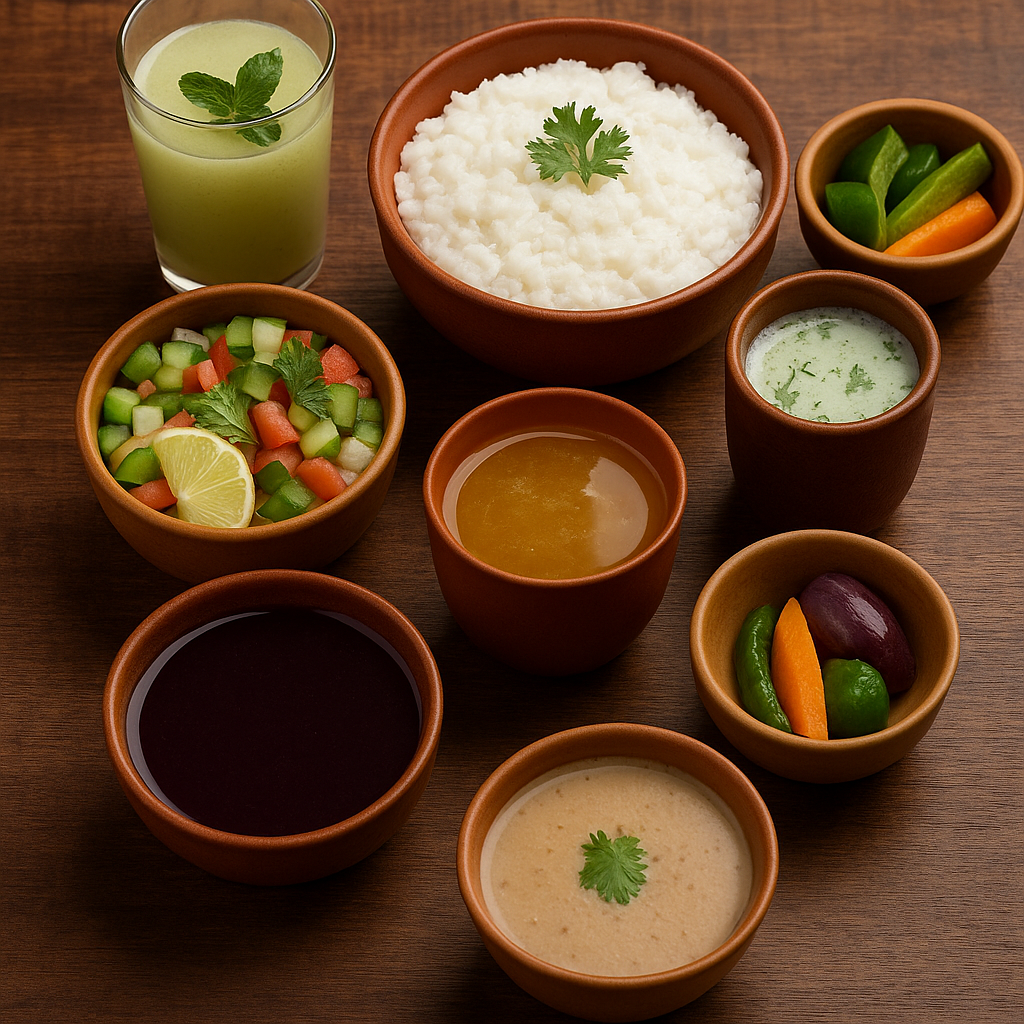As India grapples with record-breaking summer temperatures, often crossing 45°C in many regions, an age-old culinary wisdom emerges from household kitchens: food that not only feeds but heals. These dishes—crafted with locally sourced ingredients, designed for high hydration, digestion, and thermal balance—serve as natural antidotes to summer’s harsh toll.
Whether it’s the tang of raw mango, the probiotic balance of curd, or the cooling properties of kokum and bael, each dish is a testament to India’s deep-rooted tradition of climate-responsive cooking. Here are seven such culinary staples that go beyond taste, offering wellness wrapped in tradition.
1. Aam Panna: The Anti-Heatstroke Elixir
Made from boiled raw mango pulp, cumin, black salt, and mint, Aam Panna is widely consumed across north and central India. This refreshing drink replenishes lost electrolytes, prevents dehydration, and cools the internal system. It’s commonly given to children and the elderly to combat the risk of heatstroke.
Nutritional Insight: Rich in Vitamin C and pectin, it also aids digestion and boosts immunity during hot spells.
2. Curd Rice: South India’s Cooling Staple
In Tamil Nadu, Karnataka, and Andhra Pradesh, Curd Rice isn’t just a comfort food—it’s a lifeline in summers. Combining cooled rice with yogurt, mustard seeds, curry leaves, and sometimes pomegranate or raw mango, it provides gut-friendly bacteria and reduces internal heat.
Why It Works: The probiotics in curd regulate digestive enzymes and maintain electrolyte balance, essential during excessive sweating.
3. Buttermilk (Chaas): India’s Natural Hydration Tonic
Consumed in every corner of the country—from Gujarat to Odisha—buttermilk is a lightly spiced, diluted curd drink that aids digestion, fights fatigue, and prevents acidity. Variants include the Punjabi lassi, Tamil neer mor, and Maharashtrian mattha.
Climate Science Connection: Cooling spices like cumin, curry leaves, and ginger boost digestion and prevent inflammation, especially in tropical heat.
4. Kokum Sherbet: Coastal India’s Antioxidant Powerhouse
The purple-hued kokum fruit, native to the Konkan coast, is used to make a sweet-sour sherbet that’s served chilled during the sweltering months. It’s a popular remedy for acidity, fatigue, and loss of appetite in Maharashtra and Goa.
Medicinal Value: Kokum contains garcinol and hydroxycitric acid, compounds known for their anti-inflammatory and antioxidant properties.
5. Sattu Drink: Bihar’s Protein-Rich Coolant
In Bihar, Uttar Pradesh, and parts of Jharkhand, roasted gram flour or sattu is mixed with water, salt, cumin, and lemon to create a nutrient-rich drink. It’s often consumed mid-morning by laborers, farmers, and schoolchildren alike.
Nutritional Benefits: High in protein, fiber, and iron, sattu helps regulate blood sugar and keeps the body cool from within.
6. Bael Sharbat: An Ayurvedic Digestive Tonic
Prepared from the pulp of the bael or wood apple fruit, this sherbet is a staple in rural and semi-urban homes. It is revered for its ability to cleanse the digestive tract, regulate bowel movements, and prevent heat-induced fatigue.
Ayurvedic Relevance: Bael is classified as a ‘sheetal’ or cooling fruit and is used in traditional Indian medicine for liver protection and gut health.
7. Pakhala Bhata: Odisha’s Fermented Rice Tradition
Perhaps one of the most unique summer foods, Pakhala Bhata involves soaking cooked rice in water overnight and consuming it with yogurt, fried vegetables, or dried fish. Common in Odisha and parts of West Bengal and Assam, this fermented meal is rich in B-vitamins and good bacteria.
Scientific Perspective: The lactic acid produced during fermentation helps digestion and promotes a healthy microbiome, vital during heatwaves.
A Lesson from India’s Kitchens
As urban diets increasingly lean toward cold beverages, processed sugars, and packaged foods, these regional summer staples offer a masterclass in climate-responsive nutrition. Unlike synthetic coolers or supplements, these dishes are affordable, accessible, and sustainable—proving once again that tradition, when rooted in science, can be a country’s best resource.


